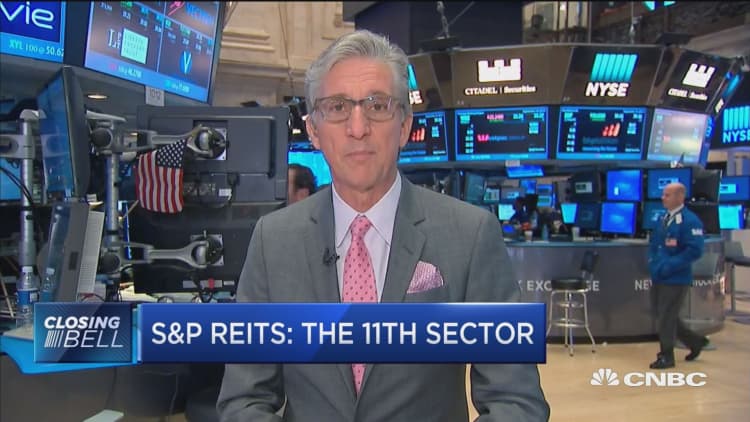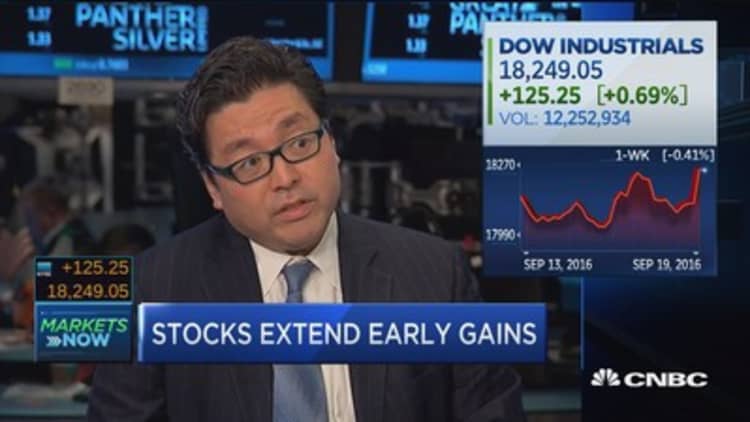
Stock market industry groups are starting to move in lockstep — a sign to some strategists that stocks will go higher.
"We've moved very broadly to these record highs, so when we look ahead that's the type of behavior we'd expect to see again," said Scott Wren, senior global equity strategist at Wells Fargo Investment Institute. His team's analysis found that less divergence — meaning, more similar, correlated performance — among the S&P 500 sectors historically results in gains for the broader market.
Divergence among the sectors is around the lowest in 10 years at 5.0 percent, according to Wren's study published Thursday. And since 1984, whenever the primary S&P 500 sectors traded in a standard deviation range of 2.4 percent to 9.6 percent, the S&P 500 on average gained 13.1 percent in the next 12 months, Wren found.
Strong gains across all the S&P 500 sectors are fundamentally important for market strength. One issue that resulted in last summer's market sell-off was narrow leadership — that is, just a handful of stocks kept the broader indexes higher, while the majority were trading well below their recent highs. That made the stock market vulnerable to shocks.
As of Monday morning trade, nine S&P 500 sectors were within 7 percent of their 52-week intraday highs, and only telecommunications was more than 8 percent below its high. An 11th S&P 500 sector, real estate, began trading Monday.
Other analysis simulating the inclusion of that 11th sector also showed that increased similarity in sector performance supports S&P 500 index gains.
Sam Stovall, U.S. equity strategist at S&P Global Market Intelligence, looked at the historical performance of the U.S. REIT Index in addition to that of the 10 S&P 500 sectors. He found that since Dec. 31, 2006, when the average daily correlation of the last 20 trading days has topped 0.85, the average S&P 500 total return for the next 20 days, including dividends, more than doubles to 1.37 percent. That correlation was 0.62 on Thursday, slightly below the average 0.77.
"Typically, you have correlations approach 1 when you're in a bear market, and the first year of a bull market," Stovall said.
S&P 500 sectors 12-month performance (indexed)
Source: FactSet
Some strategists are already positioning themselves for broad market moves — in either direction, depending on the levels of central bank stimulus.
"Heading into the fall, there's going to be a lot of central bank risk (and) a lot of political risk. Our call was, take the dispersion trade down (coming) into September," said Ilya Feygin, managing director and senior strategist at WallachBeth Capital.
The Bank of Japan and the U.S. Federal Reserve are both set to hold highly anticipated meetings on monetary policy on Tuesday and Wednesday. Besides the U.S. presidential election, a referendum in Italy and election in Spain expected later this year could also cause market volatility.
"There will be huge divergence between those sectors that want higher rates. ... The relative spread could be large, but the direction will probably be the same," Feygin said.

Against all those event-specific risks, the U.S. economy is expected to continue growing, even if it's a slow 2.5 to 3 percent annualized rate in the third quarter.
"This cycle hasn't had a lot of ebb and flow," Wren said, noting growth and inflation have continued rising modestly. "In that kind of environment where things are broader, stock picking is less important and you want to have broad exposure to the S&P 500," he said.
To be sure, in the long term, strategists still see better opportunities in certain areas of the market over others.
"When you look out longer, over month to month or quarter to quarter, that's when you see the broader dispersions among sectors," said David Lyons, global investment specialist in San Francisco for JPMorgan Private Bank.
He said that technology, energy and industrials should see better performance than the rest of the market over time.


